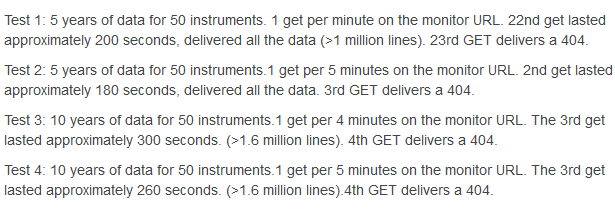A couple of questions on behalf of DSS prospect
1. Our developers have been doing some performance testing of DSS REST API TimeSeries requests, this has prompted a few questions that you may be able to help with...
We're finding this type of requests slower than expected.
- When running a testing using all of the securities within the Henderson 2 year test data (where RIC available is about 11000 instruments), requesting data for a period of 7 days, took 20 minutes to return everything.
- A second test using test code from from Thomson Reuters development community forum produces this result:

This prompts our first question: Is there any throttling or other performance limits for our test account that might explain the slower than expected speed or is this typical? Is there anything we might try that could speed this up?
Secondly, when reviewing the documentation we found the following:

Could you help clarify this for us - does this mean, that requests of the same type will be processed synchronously on the server even if a request is asynchronous?
The follow on from both of these, is a more general question regarding requests: what's the most efficient way to load timeseries data for a big list of IDs and a few years date range?




